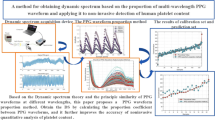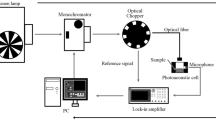Abstract
Non-invasive blood composition analysis based on dynamic spectrum (DS) theory has gained significant attention due to its non-invasive, simple, and fast performance. However, most of the multi-wavelength photoplethysmography (PPG) detection devices used to obtain DS are composed of halogen light sources and spectrometers and cannot detect effective PPG signals in the visible light short band (400–620 nm), which limits the detection accuracy of blood components with significant absorption spectral differences in that band. Therefore, this paper designs a multi-wavelength spectral acquisition system that can measure high signal-to-noise ratio (SNR > 65 dB) PGG signals at wavelengths of 405, 430, 450, 505, 520, and 570 nm and combines this system with a halogen lamp spectrometer acquisition system for non-invasive blood component detection. Furthermore, this paper collects the DS of 272 subjects with the combined system and establishes a predictive model for DS with the content of red blood cell (RBC) and hemoglobin (HGB) components. The results show that, compared with the halogen lamp spectrometer acquisition system, the correlation coefficient (Rp) of RBC and HGB prediction model established by the combined system has increased by 0.0619 and 0.0489, respectively, and the root mean square error (RMSE) has decreased by 0.08 1e12/L and 0.85 g/L, which confirm the feasibility of the designed multi-wavelength spectrum acquisition system to enhance the accuracy of blood component detection.








Similar content being viewed by others
References
Geaghan SM. Infection transmission associated with point of care testing and the laboratory’s role in risk reduction. EJIFCC. 2014;25(2):188.
Lennon AM, Buchanan AH, Kinde I, Warren A, Honushefsky A, Cohain AT, Papadopoulos N. Feasibility of blood testing combined with PET-CT to screen for cancer and guide intervention. Science. 2020;369(6499):eabb9601.
Palmqvist S, Janelidze S, Stomrud E, Zetterberg H, Karl J, Zink K, ... Hansson O. Performance of fully automated plasma assays as screening tests for Alzheimer disease–related β-amyloid status. JAMA neurol. 2019;76(9):1060–1069.
Amatuni GS, Currier RJ, Church JA, Bishop T, Grimbacher E, Nguyen AAC, ... Puck JM. Newborn screening for severe combined immunodeficiency and T-cell lymphopenia in California, 2010–2017. Pediatrics. 2019; 143(2).
Giri TK, Chakrabarty S, Ghosh B. Transdermal reverse iontophoresis: a novel technique for therapeutic drug monitoring. J Control Release. 2017;246:30–8.
Bandodkar AJ, Jia W, Yardimci C, Wang X, Ramirez J, Wang J. Tattoo-based noninvasive glucose monitoring: a proof-of-concept study. Anal Chem. 2015;87:394–8.
Menguc E; Helhel S. Relationship between human glucose level and optical de/polarization information in 600 nm–800 nm wavelength region. Photonlcs Electromagn. Res. Symp. 2019, 4343–4347.
Purvinis G, Cameron BD, Altrogge DM. Noninvasive polarimetric-based glucose monitoring: an in vivo study. J Diabetes Sci Technol. 2011;5:380–7.
Pirnstill CW, Malik BH, Gresham VC, Cote GL. In vivo glucose monitoring using dual-wavelength polarimetry to overcome corneal birefringence in the presence of motion. Diabetes Technol Ther. 2012;14:819–27.
Pirnstill CW, Malik BH, Gresham VC, Coté GL. In vivo glucose monitoring using dual-wavelength polarimetry to overcome corneal birefringence in the presence of motion. Diabetes Technol Ther. 2012;14(9):819–27.
Cameron BD, Baba JS, Coté GL. Measurement of the glucose transport time delay between the blood and aqueous humor of the eye for the eventual development of a noninvasive glucose sensor. Diabetes Technol Ther. 2001;3(2):201–7.
Tang Z, Barton SJ, Ward TE, Lowry JP, Doran MM, Byrne HJ, Hennelly BM. Multicomponent analysis using a confocal Raman microscope. Appl Opt. 2018;57(22):E118–30.
Joseph B, Pandit V, Aziz H, Kulvatunyou N, Zangbar B, Tang A, Rhee P. Transforming hemoglobin measurement in trauma patients: noninvasive spot check hemoglobin. J Am Coll Surg. 2015;220(1):93–8.
Yang D, Afroosheh S, Lee JO, Cho H, Kumar S, Siddique RH, Choo H. Glucose sensing using surface-enhanced Raman-mode constraining. Anal Chem. 2018;90(24):14269–78.
Colak YZ, Sanli M, Ucar M, Toprak HI. Accuracy of non-invasive hemoglobin monitoring by pulse CO-oximeter during liver transplantation. Minerva Anestesiol. 2017;83(5):485–92.
Sakudo A. Near-infrared spectroscopy for medical applications: current status and future perspectives. Clin Chim Acta. 2016;455:181–8.
Liu KZ, Shi M, Man A, Dembinski TC, Shaw RA. Quantitative determination of serum LDL cholesterol by near-infrared spectroscopy. Vib Spectrosc. 2005;38(1–2):203–8.
Sakudo A, Suganuma Y, Kobayashi T, Onodera T, Ikuta K. Near-infrared spectroscopy: promising diagnostic tool for viral infections. Biochem Biophys Res Commun. 2006;341(2):279–84.
Li J, Zhao X, Wu B, Ji Z, Liu H, Wang X, He Z. Non-invasive detection and differentiation of apoptotic and necroptotic cell death in vitro. J Photochem Photobiol B: Biol. 2023;244:112730.
Li G, Wang Y, Lin L, Liu Y, Li X. A noble method for noninvasive blood components measurement. Life Sci Inst. 2004;5:33–5. https://doi.org/10.3969/j.issn.1671-7929.2004.05.009.
Li G, Wang D, Liu G, Wang X, Wang K, Zhao P, Lin L. Noninvasive detection and analysis of human globulin based on dynamic spectrum. Anal Chim Acta. 2022;1191: 339298.
Li G, Wang K, Wang D, Lin L. Noninvasive blood glucose detection system based on dynamic spectrum and “M+ N ″theory. Anal Chim Acta. 2022;1201: 339635.
Li G, Cheng L, Nawaz MZ, Fan M, Lin L. A method for obtaining dynamic spectrum based on the proportion of multi-wavelength PPG waveform and applying it to noninvasive detection of human platelet content. Anal Bioanal Chem. 2022;414(19):5967–77.
Lin L, Zhang Q, Zhou M, Xu S, Li G. Calibration set selection method based on the “M+ N” theory: application to non-invasive measurement by dynamic spectrum. RSC Adv. 2016;6(114):113322–6.
Ni J, Li G, Tang W, Xiao Q, Lin L. Noninvasive human red blood cell counting based on dynamic spectrum. Infrared Phys Technol. 2021;113: 103604.
Aikens RS, Agard DA, Sedat JW. Solid-state imagers for microscopy. Methods Cell Biol. 1988;29:291–313.
Charreaux C, Guillot G, Nouailhat A, Huet D, Lambert M. Photoluminescence studies of GaxIn1− xAsyP1− y lattice-matched to InP. Physica B+ C. 1985;129(1–3):413–416.
Ojanen M, Kärhä P, Ikonen E. Spectral irradiance model for tungsten halogen lamps in 340–850 nm wavelength range. Appl Opt. 2010;49(5):880–6.
Friebel M, Helfmann J, Netz U, Meinke M. Influence of oxygen saturation on the optical scattering properties of human red blood cells in the spectral range 250 to 2000 nm. J Biomed Opt. 2009;14(3):034001–034001.
Meng F, Alayash AI. Determination of extinction coefficients of human hemoglobin in various redox states. Anal Biochem. 2017;521:11–9.
Bevilacqua V, Dimauro G, Marino F, Brunetti A, Cassano F, Di Maio A, ... Guarini A. A novel approach to evaluate blood parameters using computer vision techniques. In 2016 IEEE international symposium on medical measurements and applications (MeMeA). 2016;(pp. 1–6). IEEE.
Vardaki MZ, Schulze HG, Serrano K, Blades MW, Devine DV, Turner RF. Non-invasive monitoring of red blood cells during cold storage using handheld Raman spectroscopy. Transfusion. 2021;61(7):2159–68.
Author information
Authors and Affiliations
Corresponding author
Ethics declarations
Ethical approval and consent to participate
All studies included in this manuscript comply with ethical standards. All experiments performed were in compliance with relevant laws, as well as with the guidelines of the Tianjin First Central Hospital and the State Key Laboratory of Precision Measurement Technology and Instruments of Tianjin University. All the mentioned institutes approved the experiments. All work for this study was carried out in accordance with the code of Ethics of the World Medical Association (Declaration of Helsinki) for experiments involving humans. The volunteers gave their informed consent to participate in the study.
Consent for publication
The manuscript was approved by all authors for publication.
Conflict of interest
The authors declare no competing interests.
Additional information
Publisher's Note
Springer Nature remains neutral with regard to jurisdictional claims in published maps and institutional affiliations.
Rights and permissions
Springer Nature or its licensor (e.g. a society or other partner) holds exclusive rights to this article under a publishing agreement with the author(s) or other rightsholder(s); author self-archiving of the accepted manuscript version of this article is solely governed by the terms of such publishing agreement and applicable law.
About this article
Cite this article
Wang, Y., Li, G., Kong, L. et al. High-precision non-invasive RBC and HGB detection system based on spectral analysis. Anal Bioanal Chem 415, 6733–6742 (2023). https://doi.org/10.1007/s00216-023-04950-x
Received:
Revised:
Accepted:
Published:
Issue Date:
DOI: https://doi.org/10.1007/s00216-023-04950-x




